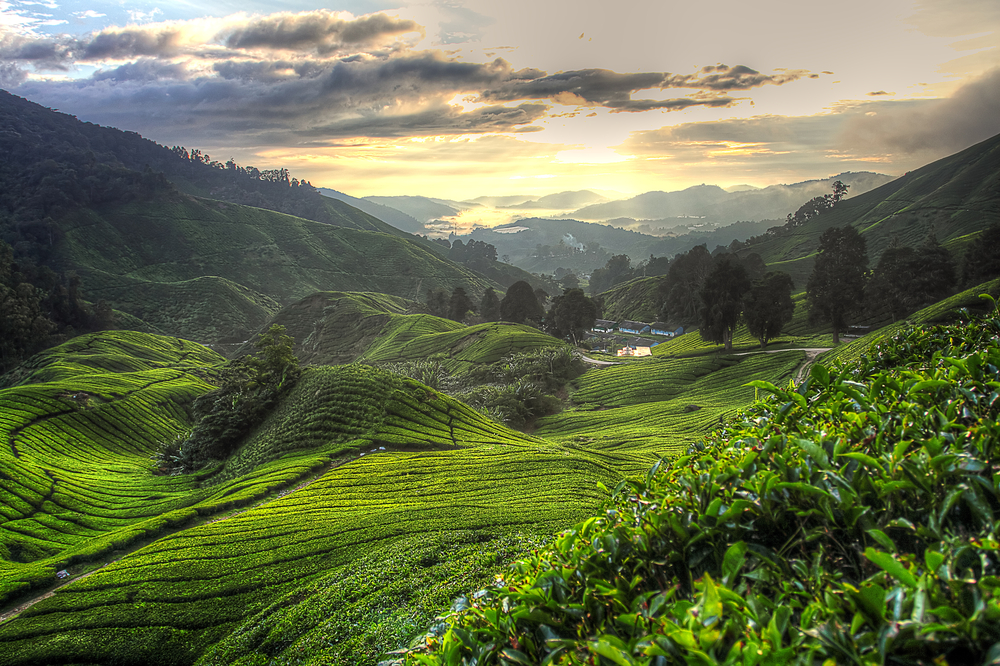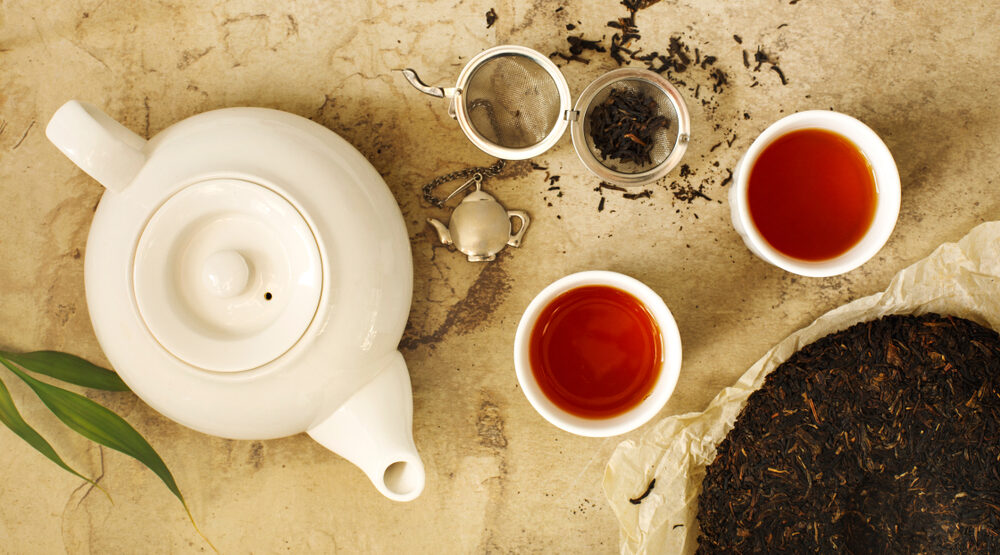From technique to beauty and tradition, wine and tea share surprising similarities
Non-alcoholic drinks are a hot topic right now. Seedlip, maker of the first distilled non-alcoholic spirit, just launched its first cocktail book. Craft beer makers like Brooklyn Brewery are releasing non-alcoholic beers. Bars across the country are building out their mocktail lists, and there are even “zero-proof bars” that eschew alcohol altogether.
But for the wine lover avoiding alcohol, a fancy seltzer or fun juice concoction may not be the most satisfactory replacement. As something to order while out with friends at a bar? Sure. As a beverage to replace the beauty and culture of wine? Probably not.
Wine has terroir, meaning the place a grape is grown imparts unique texture and flavor. Riesling grown in the blue slate soil of Germany’s Mosel Valley will be a different wine from Riesling grown in the glacial soil of Long Island. Sparkling wine made in Champagne is not the same as sparkling wine made in California, even if it’s made with the same grapes. Experiencing these micro-differences is one of the joys of drinking wine, and as fun as a mocktail may be, it cannot replicate that experience.
Wine also has centuries of tradition that give it meaning and context. That tasty little mocktail probably wasn’t lovingly grown, harvested, pressed, and bottled by a farmer whose family has worked the same land for generations, proud to be making a sort of magic in the dirt. Bottles of mocktails aren’t aged carefully in a cellar until at their peak, dusted off decades later to serve with a special dinner.
Perhaps it’s time to look to non-alcoholic beverage options that better satisfy the soul.
Tea may not have the flashiness of wine, but for lovers of the more romantic aspects of wine, it has an abundance to offer.

Ritual and Theater
Tea culture, like wine culture, is long and storied. The art and appreciation of tea, according to the 1906 book “The Book of Tea” by Kakuzo Okakura, is “founded on the adoration of the beautiful among the sordid facts of everyday existence.”
When serving tea, there is a theater akin to the theater of wine—steps for serving, proper glassware, prescribed temperatures, and layers of flavor to meditate on.
Chaxi, the ritual of precisely and artfully laying out the teaware before tea service, is “an important part of the ritual of drinking and offering tea,” said Gabriel Grippo, owner of Puerh Brooklyn tea shop in New York City. The “choreography” of preparing and serving tea, he said, brings participants together in a shared experience of beauty and meditation.
Grippo started his career in fashion design and initially moved into the tea business as a way to move away from fashion, and also because he long had been “fascinated by all hand-made teaware and Japanese aesthetics.”
“The spiritual component that tea brought into my life through its practice was unexpected and welcome,” he said.
Terroir and Technique
Also with tea, as with wine, “you can get extremely nerdy about processes, varieties, origins, flavors, notes, colors, etc.,” Grippo said.
“There are clearly terroirs and microclimates to tea,” added William Piper, sommelier at Four Horsemen in Brooklyn and a tea hobbyist. Japanese green tea tastes different from Chinese green tea, thanks both to slightly different processing methods and the different soil types and climates the tea bushes were grown in.
Wine lovers prize “old vine” wines; as a vine ages, it produces fewer grapes, but those grapes often have much more depth and complexity. With tea, “there is also a lot of talk of older ‘tree-like’ tea bushes and wild bushes,” Piper said, the teas from which are prized among tea lovers.
Of course, the maker of the tea or wine has some say, too. Make a traditional method sparkling wine and you will likely get aromas of brioche, thanks to the wine’s long contact with the yeast. Oxidize and dry your tea leaves and the resulting black tea will likely be stronger in flavor than if those leaves became an unoxidized green tea.
Aging
When executed well, aging can bring a wine or tea fully into its own, smoothing out rough edges and unveiling new levels of gravitas. Lovers of old wine can look to pu-erh (sometimes spelled pu’er), the most famous of the aged teas.
“Sometimes a pu-erh can be decades old, and if it was stored well and aged properly it would be an amazing tea, both for taste and energy,” said Grippo.
“Pu-erh teas from southern China start very intense and tannic, almost unpleasurable to drink,” said Piper—though he noted that, conversely, some tea drinkers prize their intensity and vigor. After years of aging, however, they “mellow and become harmonious, not unlike a Bordeaux.”

A secondary sort of terroir comes from the climate in which the pu-erh is aged. Unlike most teas, aging pu-erh can benefit from a humid, warm environment, as the heat and moisture encourage the microbial fermentation of the tea and mellow out its initial tannic ferocity. Piper calls this “the added terroir of aging.”
He cites an experience at the Camellia Sinensis salon in Montreal, where he was “really lucky” to taste a Dong Ding Oolong tea that had been aged in Taiwan since the ’70s: “The tea was extremely mossy and complex!” Aging the tea had brought new flavors to the fore.
Just as with wine, however, aging doesn’t always benefit tea. If you “age” a low-quality wine in your garage, the final product will likely not be pleasant. Leave a box of tea bags on your countertop for a decade and you will just end up with stale tea.
Some teas, like matcha, are best drunk as close to harvest as possible. Wines like Prosecco or Pinot Grigio are similarly prized for freshness, and not especially suitable for aging.
But if a tea or wine is of high quality, has intensity that aging could smooth into something subtler, and is stored in a temperate, consistent climate, you may just end up with something very special.
Community and Connection
And for those who miss the convivial charm of opening a bottle of wine with friends around a table, tea could be the solution.
“The sense of belonging while sharing tea is unique,” said Grippo. Piper agreed, saying that tea, like wine, “is at its most transcendent [when] enjoyed together, informally, with friends and often with food.”
Those sorts of long afternoons spent enjoying a beautiful, storied beverage—“reading the newspaper for hours at a dim sum restaurant drinking tea all the while, or playing pétanque with a carafe of rosé,” Piper offered in example—can be both ordinary and extraordinary.
Find Your Tea
Not sure where to start in the wide world of tea? Lovers of these wines may find pleasure in these corresponding teas.
Sparkling wine: Jasmine
White wine: Sencha
Red wine: Raw pu-erh
Brandy: Aged pu-erh
Christine Clark is a professional food and beverage nerd. She is a Certified Cheese Professional by the American Cheese Society and teaches cheese classes across the United States. Her work has appeared in VinePair, Bon Appetit, Fine Cooking, and Travel + Leisure.
"Tea" - Google News
December 30, 2019 at 02:32AM
https://ift.tt/37hFPVl
Are You a Sober Wine Lover? Find a Tea House - The Epoch Times
"Tea" - Google News
https://ift.tt/33ZM7GU
Shoes Man Tutorial
Pos News Update
Meme Update
Korean Entertainment News
Japan News Update
No comments:
Post a Comment